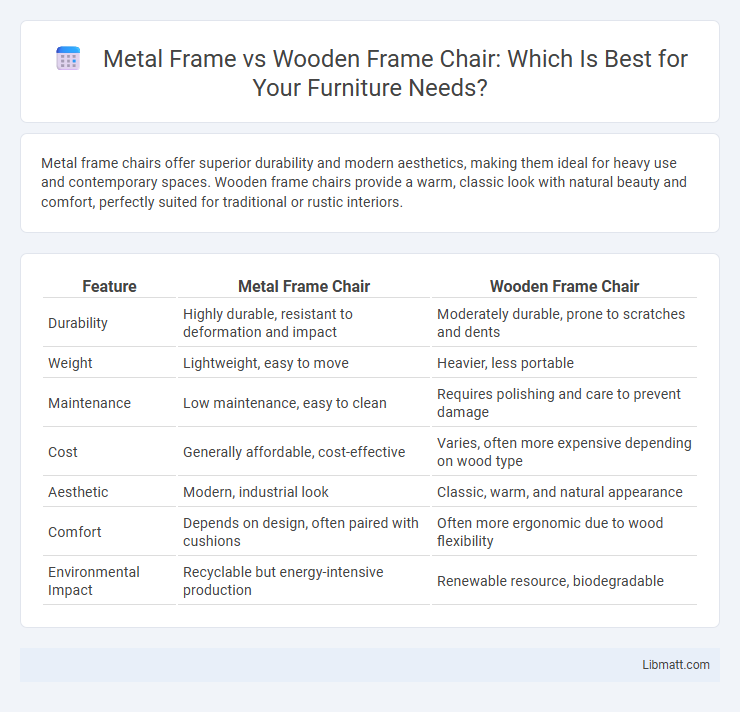Metal frame chairs offer superior durability and modern aesthetics, making them ideal for heavy use and contemporary spaces. Wooden frame chairs provide a warm, classic look with natural beauty and comfort, perfectly suited for traditional or rustic interiors.
Table of Comparison
| Feature | Metal Frame Chair | Wooden Frame Chair |
|---|---|---|
| Durability | Highly durable, resistant to deformation and impact | Moderately durable, prone to scratches and dents |
| Weight | Lightweight, easy to move | Heavier, less portable |
| Maintenance | Low maintenance, easy to clean | Requires polishing and care to prevent damage |
| Cost | Generally affordable, cost-effective | Varies, often more expensive depending on wood type |
| Aesthetic | Modern, industrial look | Classic, warm, and natural appearance |
| Comfort | Depends on design, often paired with cushions | Often more ergonomic due to wood flexibility |
| Environmental Impact | Recyclable but energy-intensive production | Renewable resource, biodegradable |
Introduction to Frame Materials: Metal vs Wood
Metal frame chairs offer superior durability, resistance to wear, and a modern aesthetic ideal for high-traffic environments. Wooden frame chairs provide natural warmth, classic style, and customizable craftsmanship, often favored in traditional or rustic settings. The choice between metal and wood hinges on factors like weight, maintenance, and design preference, impacting longevity and comfort.
Durability Comparison: Metal Frame vs Wooden Frame Chairs
Metal frame chairs offer superior durability due to their resistance to impact, moisture, and wear, making them ideal for heavy use and outdoor settings. Wooden frame chairs, while aesthetically pleasing and sturdy, are more susceptible to scratches, warping, and environmental damage over time without proper maintenance. Choosing a metal frame chair ensures longer-lasting support and resilience, enhancing your furniture investment.
Design Versatility and Aesthetic Appeal
Metal frame chairs offer sleek, modern lines and durability, making them ideal for contemporary and industrial design styles, with finishes that range from matte black to polished chrome. Wooden frame chairs provide natural warmth and timeless charm, easily customizable through various stains and finishes to fit rustic, traditional, or minimalist aesthetics. The choice between metal and wood frames significantly influences the overall ambiance, with metal frames emphasizing a clean, edgy look and wooden frames enhancing coziness and organic beauty.
Weight and Ease of Mobility
Metal frame chairs are generally lighter than wooden frame chairs, enhancing ease of mobility, especially in commercial or high-traffic settings. The durability of metal allows for thinner, more streamlined designs without sacrificing strength, making these chairs easier to carry and rearrange. Wooden frame chairs tend to be heavier due to solid wood construction, which can limit portability but often offers a sturdier feel and classic aesthetic.
Comfort Factors in Metal and Wooden Chairs
Metal frame chairs offer durability and stability but can lack cushioning, leading to less comfort over extended periods without added padding. Wooden frame chairs provide natural warmth and flexibility, enhancing comfort through ergonomic designs and softer finishes that reduce pressure points. Both frames rely on factors like seat contour, support, and cushioning materials to optimize overall comfort for users.
Maintenance Requirements: Metal vs Wooden Frames
Metal frame chairs require minimal maintenance, often needing just occasional cleaning with a damp cloth to prevent rust and corrosion, especially if coated with protective finishes like powder coating or anodizing. Wooden frame chairs demand more care, including regular dusting, polishing, and protection against moisture and pests to maintain structural integrity and appearance. Proper maintenance extends the lifespan of both materials, but wooden frames generally require more frequent and intensive upkeep compared to metal frames.
Sustainability and Environmental Impact
Metal frame chairs often have a higher environmental footprint due to the energy-intensive extraction and processing of metals but offer durability and recyclability, which can reduce long-term waste. Wooden frame chairs, especially those made from sustainably sourced or reclaimed wood, tend to have a lower carbon footprint and biodegrade more easily, promoting a circular lifecycle. Choosing FSC-certified wood or recycled metal significantly enhances sustainability by supporting responsible resource management and reducing ecological damage.
Cost Analysis: Initial and Long-term Investment
Metal frame chairs typically have a higher initial cost due to the price of materials and manufacturing processes but offer greater durability and lower maintenance expenses over time. Wooden frame chairs usually require a lower upfront investment but may incur higher long-term costs related to repairs, refinishing, and potential replacement due to wear or damage. Evaluating the total cost of ownership reveals that metal frames often provide better value for environments with heavy use, while wooden frames may suit budget-conscious buyers prioritizing aesthetics.
Common Uses and Ideal Settings
Metal frame chairs are commonly used in commercial spaces like offices, conference rooms, and cafeterias due to their durability and ease of maintenance. Wooden frame chairs are ideal for residential settings, dining rooms, and traditional or rustic interiors where aesthetics and comfort are prioritized. Both types serve different purposes, with metal frames excelling in high-traffic environments and wooden frames favored in cozy, decorative spaces.
Choosing the Right Frame Material for Your Needs
Metal frame chairs offer durability, strength, and modern aesthetics, making them ideal for high-traffic areas or outdoor use due to their resistance to wear and weather conditions. Wooden frame chairs provide warmth, classic appeal, and can be easily customized or refinished, fitting well in traditional or cozy interior settings. Selecting the right frame material depends on factors like desired style, maintenance requirements, environment, and budget to ensure long-lasting comfort and functionality.
Metal frame vs wooden frame chair Infographic

 libmatt.com
libmatt.com